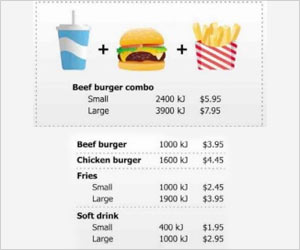An estimated third of adult Americans are obese and that number is expected to rise to 42 percent by 2030, among the highest of any country in the world.

‘Menu-labeling with calorie count for each food item do not have any impact in reduction of calories consumed by people at fast-food outlets in the United States. But still it influenced them to choose a lower-calorie item, even if it did not reduce overall caloric intake.’





The study, in which researchers compared food orders in places with and without calorie counts, is believed to be the first long-term analysis of the effects of menu labeling in the United States. Researchers say it also offers early evidence of its possible impact as the federal government prepares to introduce the policy nationwide in December 2016 as part of its Affordable Care Act.Researchers found that the average number of calories bought by patrons at each sitting between January 2013 and June 2014 was statistically the same as those in a similar survey of 1,068 fast-food diners in 2008, when New York City initially imposed menu labeling. Diners were surveyed at major fast-food chains: McDonald’s, Burger King, KFC, and Wendy’s.
Calorie counts in the 2013-2014 analysis averaged between 804 and 839 per meal at menu-labeled restaurants, and between 802 and 857 per meal at non-labeled eateries; whereas, they averaged 783 per meal for labeled restaurants and 756 per meal for non-labeled restaurants shortly after the policy was introduced.
For the surveys, diners entering the fast-food restaurant were asked to return their itemized receipt to research assistants and answer some follow-up questions in person in exchange for two dollars.
“Our study suggests that menu labeling, in particular at fast-food restaurants, will not on its own lead to any lasting reductions in calories consumed,” says study senior investigator Brian Elbel, an associate professor in the Department of Population Health at NYU Langone and at the NYU Wagner Graduate School of Public Service
Advertisement
There is still cause for optimism, he says, because the current and previous studies show at least some awareness of the bloated calorie counts in most fast food. “People are at least reading the information, some are even using it,” says Elbel, pointing out that among the study results from 2008, some 51 percent of survey respondents reported noticing the calorie counts, and 12 percent claimed that it influenced them to choose a lower-calorie item, even if it did not reduce overall caloric intake.
Advertisement
An estimated third of adult Americans are obese (with a body mass index of 30 or more), and that number is expected to rise to 42 percent by 2030, among the highest of any country in the developed world, he says.
Elbel says continued and closer monitoring of the impact of menu labeling should also boost success rates by showing more clearly where, for whom, and what kind of labeling shows the most promise. Potentially, he says, “labels may yet work at non-fast-food, family-style restaurant chains, or for specific groups of people with a greater need than most to consume fewer calories and eat more healthily. We will have to wait and see, while continuing to monitor and analyze the policy’s impact.”
Source- Newswise














